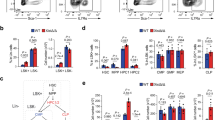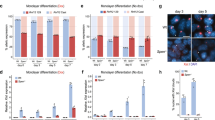Abstract
During early embryogenesis of female mammals, one of the two X chromosomes is randomly chosen to be inactivated in each cell1, leading to the transcriptional silencing of thousands of genes on this chromosome. This random X-inactivation process also occurs during in vitro differentiation of female embryonic stem (ES) cells2,3,4. A locus on the X chromosome, the X inactivation centre (Xic) is initially 'counted', given that at least two copies of Xic must be present per diploid genome in order for inactivation to occur2. The counting process ensures that one X chromosome remains active in diploid cells. In the mouse, the essential functions of Xic can be assured by a 450-kb region5,6 containing the Xist gene. Xist maps within Xic (refs 7, 8, 9, 10) and is necessary in cis for inactivation11,12. The Xist transcript is a 15-kb RNA which is confined within the nucleus and coats the inactive X chromosome13. In order to characterize functional elements within Xic and the Xist gene, we created a 65-kb cre/loxP deletion extending 3′ to Xist exon 6. In undifferentiated ES cells, Xist expression from the deleted X chromosome was markedly reduced. In differentiated XX ES cells containing one deleted X chromosome, the X inactivation process still occurred but was never initiated from the unmutated X chromosome. In differentiated ES cells that were essentially XO, the mutated Xic was capable of initiating X inactivation, even in the absence of another Xic. These results demonstrate a role for the region 3′ to Xist exon 6 in the counting process and suggest that counting is mediated by a repressive mechanism which prevents inactivation of a single X chromosome in diploid cells.
This is a preview of subscription content, access via your institution
Access options
Subscribe to this journal
Receive 12 print issues and online access
$209.00 per year
only $17.42 per issue
Buy this article
- Purchase on Springer Link
- Instant access to full article PDF
Prices may be subject to local taxes which are calculated during checkout




Similar content being viewed by others
References
Lyon, M.F. Gene action in the X chromosome of the mouse (Mus musculus L.). Nature 190, 372–373 ( 1961).
Rastan, S. & Robertson, E.J. X-chromosome deletions in embryo-derived (EK) cell lines associated with lack of X-chromosome inactivation. J. Embryol. exp. Morph. 90, 379–388 (1985).
Sheardown, S.A. et al. Stabilization of Xist RNA mediates initiation of X chromosome inactivation . Cell 91, 99–107 (1997).
Panning, B., Dausman, J. & Jaenisch, R. X chromosome inactivation is mediated by Xist RNA stabilization. Cell 90, 907–16 ( 1997).
Lee, J.T., Strauss, W.M., Dausman, J.A. & Jaenisch, R. A 450 kb transgene displays properties of the mammalian X-inactivation center. Cell 86, 83–94 ( 1996).
Herzing, L.B.K., Romer, J.T., Horn, J.M. & Ashworth, A. Xist has properties of the X-chromosome inactivation centre. Nature 386, 272–75 (1997).
Borsani, B. et al. Characterization of a murine gene expressed from the inactive X chromosome . Nature 351, 325–329 (1991).
Brown, C.J. et al. The human XIST gene: analysis of a 17 kb inactive X-specific RNA that contains conserved repeats and is highly localized within the nucleus. Cell 71, 527–542 ( 1992).
Brockdorff, N. et al. Conservation of position and exclusive expression of mouse Xist from the inactive X chromosome. Nature 351, 329 –331 (1991).
Brockdorff, N. et al. The product of the mouse Xist gene is a 15kb inactive X-specific transcript containing no conserved ORF and located in the nucleus. Cell 71, 515–526 (1992).
Penny, G.D., Kay, G.F., Sheardown, S.A., Rastan, S. & Brockdorff, N. The Xist gene is required in cis for X chromosome inactivation. Nature 379, 131 –137 (1996).
Marahrens, Y., Panning, B., Dausman, J., Strauss, W. & Jaenisch, R. Xist-deficient mice are defective in dosage compensation but not spermatogenesis. Genes Dev. 11, 156–166 (1997).
Clemson, C.M., Mc Neil, J.A., Willard, H.F. & Lawrence, J.B. XIST RNA paints the inactive X chromosome at interphase: evidence for a novel RNA involved in nuclear/chromosome structure. J. Cell Biol. 132, 259–275 ( 1996).
Ramirez-Solis, R., Liu, P. & Bradley, A. Chromosome engineering in mice. Nature 378, 720–724 (1995).
Simmler, M.C. et al. A 94kb genomic sequence 3′ to the murine Xist gene reveals an AT rich region containing a new testis specific gene Tsx. Hum. Mol. Genet. 5, 1713–1726 (1996).
Panning, B. & Jaenisch, R. DNA hypomethylation can activate Xist expression and silence X-linked genes. Genes Dev. 10, 1991–2002 (1996).
Simmler, M.C. et al. Localization and expression analysis of a novel conserved brain expressed transcript, Brx/BRX, lying within the Xic/XIC candidate region. Mamm. Genome 8, 760– 766 (1997).
Marahrens, Y., Loring, J. & Jaenisch, R. Role of Xist gene in X chromosome choosing. Cell 92, 657–664 (1998).
Rastan, S. Non-random X-chromosome inactivation in mouse X-autosome translocation embryos - location of the inactivation centre. J. Embryo. exp. Morph. 78, 1– 22 (1983).
Plenge, M.R. et al. A promoter mutation in the Xist gene in two unrelated families with skewed X-chromosome inactivation. Nature Genet. 17, 353–356 (1997).
Cattanach, B.M., Perez, J.N. & Pollard, C.E. Controlling elements in the mouse X-chromosome. Genet. Res. 15, 189–195 (1970).
Cattanach, B.M. Control of chromosome inactivation. Annu. Rev. Genet. 75, 1–18 (1975).
Rastan, S. Primary non-random X-inactivation caused by controlling elements in the mouse demonstrated at the cellular level. Genet. Res. 40, 139– 147 (1982).
Courtier, B., Heard, E., Arnaud, D. & Avner, P. Xce haplotypes show modified methylation in a region of the active X chromosome lying 3′ to Xist. Proc. Natl Acad. Sci. USA 92, 3531–3535 (1995).
Heard, E. et al. Physical mapping and YAC contig analysis of the region surrounding Xist on the mouse X chromosome. Genomics 15, 559–569 (1993).
Kuehn, M., Bradley, A., Robertson, E.J. & Evans, M. A potential animal model for Lesh-Nyhan syndrome through introduction of HPRT mutations into mice. Nature 326, 295–298 (1987).
Kay, G.F. et al. Expression of Xist during mouse development suggests a role in initiation of X chromosome inactivation. Cell 72, 171 –182 (1993).
Robertson, E.J. Teratocarcinomas and embryonic stem cells, a Practical approach (IRL, Oxford, 1987).
Lawrence, J.B., Singer, R.H. & Marselle, L.M. Highly localized tracks of specific transcripts within interphase nuclei visualized by in situ hybridization. Cell 57, 493–502 ( 1989).
Rougeulle, C., Colleaux, L., Dujon, B. & Avner, P. Generation and characterization of an ordered lambda clone array for the 460kb region surrounding the murine Xist sequence. Mamm. Genome 5, 416– 423 (1994).
Acknowledgements
Thanks are due to D. Arnaud for generating the HP3.10 ES cell line and for technical help with the 6-TG selection and to E. Heard and F. Mongelard for establishing RNA FISH in the laboratory. F. Huetz and K. Rajewsky provided helpful advice on homologous recombination, and D. Cunningham, E. Heard, B. Robert and M. Wiles fruitful discussions. We are grateful to A. Bird, A. Bradley, S. O'Gorman, J.T. Lee and C. Vourc'h for the gifts of plasmids pBam7.6, pPGKpuro.bpA, pOG231, pXist3K, and p68. We thank F. Huetz and A. Stafford for critical reading of the manuscript. This work was supported by grants to P. A. from the Association Francaise contre la Myopathie (AFM), and the Association pour la Recherche contre le Cancer (ARC).
Author information
Authors and Affiliations
Corresponding author
Rights and permissions
About this article
Cite this article
Clerc, P., Avner, P. Role of the region 3′ to Xist exon 6 in the counting process of X-chromosome inactivation. Nat Genet 19, 249–253 (1998). https://doi.org/10.1038/924
Received:
Accepted:
Issue Date:
DOI: https://doi.org/10.1038/924
This article is cited by
-
Α de novo 3.8-Mb inversion affecting the EDA and XIST genes in a heterozygous female calf with generalized hypohidrotic ectodermal dysplasia
BMC Genomics (2019)
-
Generation of Isogenic Controls for In Vitro Disease Modelling of X-Chromosomal Disorders
Stem Cell Reviews and Reports (2019)
-
Thoughts about SLC16A2, TSIX and XIST gene like sites in the human genome and a potential role in cellular chromosome counting
Molecular Cytogenetics (2016)
-
Long nonoding RNAs in the X-inactivation center
Chromosome Research (2013)
-
Reactivation of the inactive X chromosome in development and reprogramming
Cellular and Molecular Life Sciences (2013)



